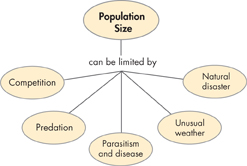5.2 Limits to Growth
 What factors determine carrying capacity?
What factors determine carrying capacity? What limiting factors depend on population density?
What limiting factors depend on population density? What limiting factors do not typically depend on population density?
What limiting factors do not typically depend on population density?
limiting factor
density-dependent limiting factor
density-independent limiting factor
Outline Make an outline using the green and blue headings in this lesson. Fill in details as you read to help you organize the information.
THINK ABOUT IT Now that you've seen how populations typically grow in nature, we can explore why they grow as they do. If populations tend to grow exponentially, why do they often follow logistic growth? In other words, what determines the carrying capacity of an environment for a particular species? Think again about hydrilla. In its native Asia, populations of hydrilla increase in size until they reach carrying capacity, and then population growth stops. But here in the United States, hydrilla grows out of control. The same is true of gypsy moths and many other introduced plant and animal species. Why does a species that is “well-behaved” in one environment grow out of control in another?

Limiting Factors
 What factors determine carrying capacity?
What factors determine carrying capacity?
Recall that the productivity of an ecosystem can be controlled by a limiting nutrient. A limiting nutrient is an example of a general ecological concept: a limiting factor. In the context of populations, a limiting factor is a factor that controls the growth of a population.
As shown in Figure 5–6, there are several kinds of limiting factors. Some—such as competition, predation, parasitism, and disease—depend on population density. Others—including natural disasters and unusual weather—do not depend on population density.  Acting separately or together, limiting factors determine the carrying capacity of an environment for a species. Limiting factors keep most natural populations somewhere between extinction and overrunning the planet.
Acting separately or together, limiting factors determine the carrying capacity of an environment for a species. Limiting factors keep most natural populations somewhere between extinction and overrunning the planet.
Charles Darwin recognized the importance of limiting factors in shaping the history of life on Earth. As you will learn in Unit 5, the limiting factors we describe here produce the pressures of natural selection that stand at the heart of evolutionary theory.

FIGURE 5–6 Limiting Factors Many different factors can limit population growth. Some of these factors depend on population density, while others do not. Infer How might each of these factors increase the death rate in a population?
d
Table of Contents
- Formulas and Equations
- Applying Formulas and Equations
- Mean, Median, and Mode
- Estimation
- Using Measurements in Calculations
- Effects of Measurement Errors
- Accuracy
- Precision
- Comparing Accuracy and Precision
- Significant Figures
- Calculating With Significant Figures
- Scientific Notation
- Calculating With Scientific Notation
- Dimensional Analysis
- Applying Dimensional Analysis




